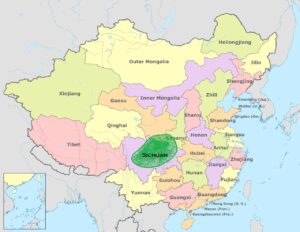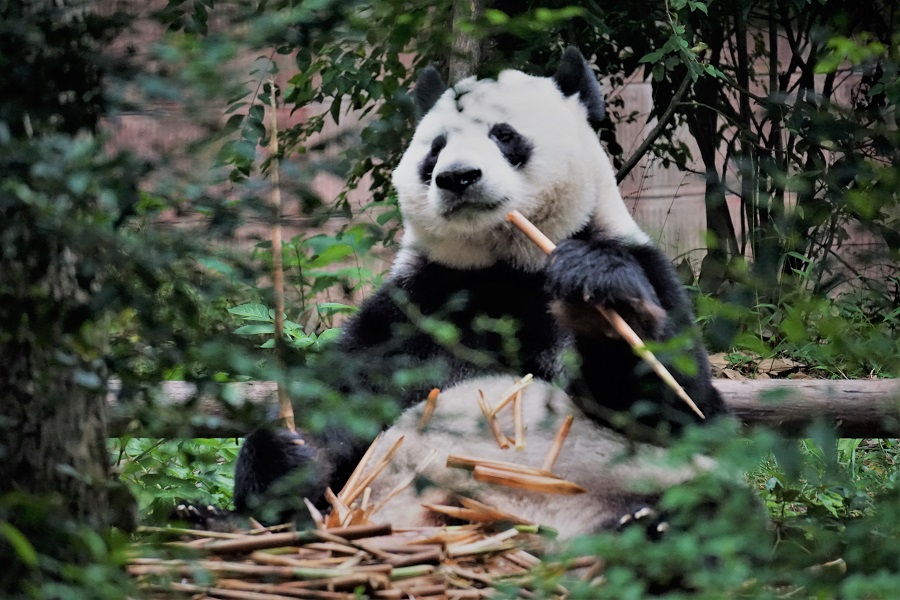Panda Introduction
Scientific Name: Ailuropoda melanoleuca (literally translated as something like a black and white cat foot, or something like that!)
Pandas are fairly small bears with males reaching 150Kg (about twice as heavy as a human) and females 125Kg. For reference male polar bears often reach 450Kg and brown bears 600Kg. Although we call them panda bears there has been some controversy over whether they are in fact bears, a kind of raccoon, or their own family but it is generally accepted that bears are the panda’s closest relatives.
In the wild pandas grow to be about 20 years old but in captivity, they can reach 30+ years with the oldest panda recorded at 36 years.
Panda Appearance
The Giant Panda is a very unique-looking bear. They have black and white colouring with black patches around their eyes, black legs, black shoulders, and black ears. Their fur is very thick to enable them to keep warm in their mountain habitat. It may seem strange but their markings actually help with camouflage as their white fur helps in the snowy environment and the black fur is camouflaging in shade.
Do pandas have white or black tails?
Pandas have cute white tails, white heads and white stripes across their bodies whilst their ears are black, along with their legs and the fur around their eyes.
Much like many other mammals, panda fur protects them from the cold, wet climate in which they live. Their habitat is warmer in summer so they don’t need such a thick pelt all year round so, like other creatures, they undergo moulting to thin out their fur. Unfortunately much like almost everything else to do with the panda, its diet of bamboo controls their moult. It does not give them enough energy to undergo a seasonal moult so they have to do it in stages. This often gives them a patchy appearance in summer which can be confused with ill-health but is in fact very normal.
Panda Movement
The rear paws of the panda point inwards which gives the panda a cute waddling gait. They are actually quite acrobatic though and can easily stand on their hind legs and have been observed somersaulting, rolling, and dust bathing.
Despite their rather clumsy appearance and reputation, giant pandas are actually excellent climbers (although they do look a bit awkward climbing trees!).
Do pandas swim?
Like other bears, pandas are strong swimmers but they tend to spend very little time in the water as there are no oceans and not many lakes in their mountain habitats and they do not need to go into the water to hunt.
How fast do pandas move?
Compared to some other bears, pandas move quite slowly and clumsily. They are certainly not apex hunters! Their average walking speed is between 1.2 and 1.8 mph but they can actually get up to 20 mph at top speed.

Panda Diet/Panda feeding
What does a panda eat? A panda’s diet consists of 99% bamboo. Although there are around 40 different kinds of bamboo that a panda will eat in the wild, this is certainly not a very varied diet. In addition, they need at least two varieties of bamboo in their habitat or they will starve.
Although they are not good hunters, wild pandas will also prey upon small animals such as mice occasionally and take eggs if they can find them which makes up that other 1% of their diet. This means that in captivity they are also fed some fruits and soya-based animal feed so that they can get enough nutrients.
Panda Adaptations
What adaptations do pandas have?
Pandas have a number of specific adaptations that enable them to eat bamboo which makes up the majority of their diet. They have an enlarged wrist bone that acts like an opposable thumb so they can grab hold of the bamboo and their molar teeth have become very flat so they can crush and chew the bamboo. This thumb adaptation is not actually a thumb but makes it appear that pandas have five fingers and a thumb. In addition, panda throats have developed a thick lining to protect them from bamboo splinters when swallowing.
Dental records show that they started eating bamboo as their food source around three million years ago.
So, do pandas have 6 fingers?
Sort of. They have evolved so that their enlarged wrist bone has taken on the role of being a thumb so that the pandas can hold bamboo. They also have five other fingers so it looks as though they have six in total.

Panda digestion
Despite the physical adaptations in their teeth and paws, pandas retain the digestive system of their carnivore ancestry and are unable to digest cellulose which unfortunately makes up the main part of bamboo. They partially get around this issue by passing a huge amount of bamboo through their digestive system each day, spending more than half the day eating and pooing up to 40 times a day!
Panda Habitat
What climate do pandas live in?
Giant pandas live in the mountainous regions of Central China. The climate there is cold and wet.
Why are giant pandas endangered?
Pandas are currently classified as vulnerable, having moved from endangered in 2016. Their numbers are slowly improving and there is a concerted effort in China to protect their habitat. The pandas became endangered due to the human destruction of their habitats. They are very reliant on bamboo forests as this accounts for 99% of their food and in addition, they are rather slow reproducers.
So, although panda numbers are improving their almost total reliance on bamboo makes them vulnerable. A particular issue is that once bamboo flowers, it dies back and can take a few years to recover. In the past, the pandas just moved on to other bamboo forests but as their habitat reduced, this became less possible which exacerbated their decline.

Where do pandas live?
Pandas are now confined to the bamboo forests of South West China but fossil records show that they once had a much wider range. In the Pleistocene era, pandas inhabited much of China as far north as where Beijing stands now along with Northern Myanmar and parts of Vietnam.
Human destruction of the panda’s habitat along with poaching means that the giant panda is now limited to remote areas of mountain habitat along the Eastern edge of the Tibetan plateau in the Chinese provinces of Sichuan (Szechwan), Shaanxi (Shensi), and Gansu (Kansu).
According to the IUCN Red List of Threatened Species, fewer than 1,900 pandas are thought to remain in the wild but in 2016 the organisation changed the Panda’s status to vulnerable. This is predominantly due to the improved Chinese efforts of conservation. The panda has become a very important symbol of China which has led to much greater protection of habitats and success in restoring some of the lost bamboo forests.
There are now around 40 Giant panda reserves in China that are connected with “corridors” in order to reduce the fragmentation of the panda population. This is necessary as villages and other human activities would otherwise block panda migrations.

Pandas in Captivity
There are currently around 120 pandas in captivity in China and some 20 in zoos elsewhere and captive panda populations are increasing. The pandas in overseas zoos are generally part of commercial loan agreements with the proceeds being used to further protect the panda numbers.
US Zoos with pandas
At the time of writing, there are three zoos in the USA with pandas – Washington DC, Memphis, and Atlanta. There are also pandas in zoos in the UK, Australia, Canada, Japan, Finland, Malaysia, Thailand, Mexico, France, Singapore, Spain, Austria, Belgium, and Russia. Non-Chinese zoos must lease the bears from the Chinese government with the money going back into their conservation.
Panda Behaviour
So what do pandas do all day? Well, they spend half their time eating and half their time sleeping so they will be asleep for around 50% of the time.
How long do pandas sleep?
Although they spend almost half of their time sleeping, pandas only sleep for about 2-3 hours at a time. Their schedule is generally eating bamboo for 3-4 hours then sleep for 2-3 hours and repeat.
Unlike some other bears, pandas do not hibernate as their diet means they cannot store fat. If it is too cold in the mountains they will just move to lower ground into the valleys.
Pandas have excellent hearing and sense of smell but their eyesight is poor, although they are able to see adequately in the dark so they can move around at night without any problems.
Pandas are generally solitary and each panda has a range of only 4-6 square km, although they often overlap somewhat. A scent gland is used to rub against trees and rocks which gives a lot of information about the panda that left it – such as sex and social status. In males, this functions to indicate where the pandas have been but in females, it is used to signal estrus, which occurs annually in spring and lasts only a few days.
Males locate females first by this scent marking technique and is honed down using vocalisations. During this time males can become aggressive with each other as they compete to mate with the female.
Studies have been conducted in China looking at several different panda vocalisations and have translated 13 different ones. Panda cubs are able to make three different vocalisations and can express whether they are not happy, hungry or if something is “nice”. A panda mother will tweet like a bird if she is anxious about her cubs and will bark if a stranger is nearby, which means “get out of my place”. Male and female pandas also make different noises to each other before mating.
Panda Reproduction
Why do pandas give birth to tiny babies?
Pandas give birth to tiny babies. When born they weigh just 100g which is 1/900th of the adult size (for comparison human babies are 1/20th of adult size) and this is the smallest relative size of any placental mammal. The reason for the diminutive size of the babies is not fully understood but is thought to be a result of the panda’s diet as it is just not nutritious enough to carry the babies for longer. This is a trait seen to a lesser extent in other bears, however.
Pandas usually only give birth to a single baby but if twins are born, the mother will often only choose to raise the stronger one. Again the reason for this is that bamboo diet – she is not able to make enough milk to raise more than one baby.
How long is a panda pregnancy?
A panda pregnancy lasts from just three to five months.
Panda Babies
Panda mothers give birth from July to September with a gestation period of just three to five months. New-born giant pandas are pink, blind, and furless, they start growing fur after about three weeks.
They are very vulnerable when they are young and totally dependent on their mother. It takes around three months for them to be able to walk, five months to start climbing and at six months the babies are able to start eating bamboo and are gradually weaned off their mother’s milk. They are fully weaned after a year but will continue to live with their mother until she gets pregnant again.
Do pandas kill their babies?
Not directly but in the wild if there are twins born the mother will choose to raise only the strongest. There have also been several cases of the mother accidentally crushing the baby.

Panda predators
What animals attack pandas?
Despite their appearance as a cute, cuddly creature, pandas actually retain some of their sharp carnivore teeth. They are strong and have powerful jaws so very few animals would risk attacking a giant panda. When pandas are young or juvenile, they could be at risk from predators such as jackals, snow leopards, and yellow-throated martens, however.
Do pandas attack humans? Can they be dangerous?
Generally speaking, pandas are gentle herbivores but they are still wild bears and have sharp teeth and powerful jaws. The panda’s reputation of being a soft cuddly creature can lull people into a false sense of security. In 2006 a drunk man climbed into the panda enclosure in a Beijing zoo and tried to pet the panda there. He ended up with a huge chunk being taken out of his leg by the not-too-impressed panda residing there. This is not an isolated incident, two other people have been attacked by pandas at the zoo after entering their enclosures. So, don’t go petting any giant pandas you are lucky enough to see in the wild, people!

